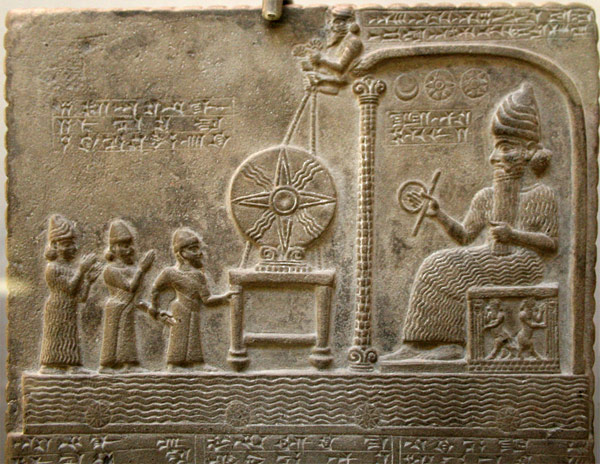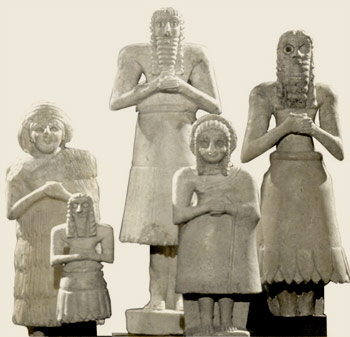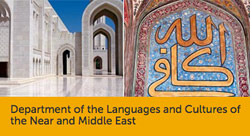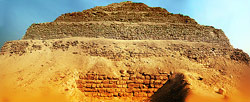
Mesopotamia:
Worldview and Beliefs
Tablet of Shamash relief. Wikimedia Commons (Prioryman).
In the Mesopotamian worldview, illnesses and strife were caused by evil demons or by divine displeasure.
The ancient Mesopotamians believed that the world depended entirely upon the superhuman forces that created it, and these formidable forces did so entirely for their own advantage. For example, Ea is the creator and protector of humanity in the Babylonian flood myth Atrahasis (Atra-hasīs) and the Epic of Gilgamesh (Gilgameš). It was he (Ea) who came up with the plan to create humans out of clay so that they could perform work for the gods. But the supreme god Enlil attempted to destroy Ea’s newly created humans with a devastating flood, because their never-ending noise prevented him from sleeping. But clever Ea foresaw Enlil’s plan and instructed a sage named Atrahasis, whose name means “Extra Wise,” to build an ark so that humanity could survive.
“…everywhere, religion was used by the powerful to stay powerful. Hence the similarity in the way scholars describe civilizations separated by an ocean. Mayan kings were ‘conduits through which supernatural forces were channeled into the human realm.’ The Egyptian king was ‘the sole intermediary who could serve the gods and hence maintain the flows of energy’ into the world.”
Robert Wright says in his book The Evolution of God, “Like the gods of prehistory, these gods expected goods and services from humans, and dished out rewards or punishment accordingly. So everywhere people made sacrifices to the gods, flattered—that is, worshipped—them, and tended to their needs in other ways. (A Mesopotamian tablet of ritual instruction begins, ‘When you wash the mouth of a god….’) Everywhere the upshot was a symbiotic relationship between people and gods, with each having something the other needed. And everywhere—as in chiefdoms—the political leaders took the lead in mediating that relationship, and indeed defining the relationship; everywhere, religion was used by the powerful to stay powerful. Hence the similarity in the way scholars describe civilizations separated by an ocean. Mayan kings were ‘conduits through which supernatural forces were channeled into the human realm.’ The Egyptian king was ‘the sole intermediary who could serve the gods and hence maintain the flows of energy’ into the world.”
The supernatural world and the way it worked was modeled on the Mesopotamian’s earthly world where the monarch reigned at the top of a pyramid of subordinate authorities whose power emanated from his. As Jean Bottéro writes in Religion in Ancient Mesopotamia, “Just as their king governed the country, directly or through ‘vicars,’ by expressing his wishes, by making decisions, and by communicating them, the gods also made the world function according to their designs, by deciding the destinies of all beings, as individuals or collectively.”
Mesopotamian culture survived over 4,000 years, with myths, poetry, legends and artifacts reinterpreted again and again, their older versions enduring side by side with the newer which were subject to repeated reinterpretations. So, it is difficult for scholars to establish definitively a coherent timeline of the evolution of the thinking of these ancient peoples. According to Thorkild Jacobsen in his book The Treasures of Darkness, three major aspects or phases of Mesopotamian religion occurred: Initially, worship focused on survival—the power of fertility and plenty—what we have previously called “cosmic maintenance”; later the concept of the ruler was added along with issues of security from enemies and expansion of territory; and lastly at the end of the third millennium BCE, “once the fortunes of the individual increased in importance until they rivaled those of the communal economy and security,” then the personal god is added.

To the Mesopotamians, the god was present in an object and caused it to be, thrive and flourish. The Sumerian word both for “sun” itself and the invisible, august and powerful deity within it was Utu and the moon god was Nanna, which is also the word for “moon.” Unlike the idea of a transcendent god or gods, says Jacobsen, for the Mesopotamians, “The Numinous was the indwelling spirit and power of many phenomena and situations and it differed with each of them. Thus, ancient Mesopotamian religion was conditioned to a pluralistic view, to polytheism, and to the multitude of gods and divine aspects that each recognized.”
So, like the Greeks seven centuries later, the Mesopotamians believed in a pantheon of gods. There were deities connected with various professions, such as scribes and builders. “Mesopotamia had gods for everything from brickmaking to brewing” says Wright—even including, apparently, a Lord of Livestock Pens! Each city-state had its own patron god or goddess who belonged to this pantheon, such as:
- Anu, representing the sky and the patron god of Erech (Uruk) and Der
- Enlil (Bel), the god of air and the patron deity of the city of Nippur
- Enki (Aa or Ea), the god of the fresh groundwater (Apsu) and of the city of Eridu
- Ninhursag, the mother goddess and the goddess of Kish
- Nanna (Sin), the moon god of Ur and father of the sun (Utu)
- Utu (the sun), the patron deity of the city of Larsam
- Inanna, the war and love goddess and patron of Unug and Zabalam
- Ishtar, a goddess of love and of war and the patron of Agade, Nineveh and Arbela
- Nina, another goddess like Ishtar at Nina
- Hadad or Rimmon (the storm god), the god at Muri, Ennigi and Kakru
- Nergal (Mars), a plague and war god at Cuthah
- Allatu (Erishkigal), the goddess of the underworld
In order to ensure the presence of this power, the gods were provided with “a place.” Thus, divine images were fashioned which became the gods themselves. Participants in cult dramas actually became the god(s) in question—literally a re-presentation that is able to, in the words of Thorkild Jacobsen, “fulfill the divine will with all its beneficent results for the community.” The creative power of the word itself was also a way to evoke the gods, particularly in the early periods. Literature of praise and lament, of myths, epics and disputations, all activated their latent supernatural power.
Similarly, worshippers could create statues of themselves to stand in perpetual prayer on their behalf before the god or goddess to whom the sanctuary was dedicated. When the temples were renovated, those statues that had fallen into disrepair or outlived the terms of their dedication were carefully buried within the building.

Above all, the temple house was built to achieve and insure the divine presence. Just as the owner of a house would be present in his home, the god’s presence and power filled the house. As the place of the god, the temple was sacred, awesome, set apart from the secular activities of the world and visited only by the priesthood. Every temple was different, since every temple held an individual god, its presence reflecting the specific nature and function of that god—an embodiment.
There was a hierarchy in the world of the gods and only those who controlled the fundamental way the universe ran were considered major deities. Enki, the god of fresh water and Lord of Wisdom, was one as were the gods of the sky, the sun and the air. Although these gods were served and revered by everyone, they were quite distant and unconnected to ordinary life. The bridging of the cosmic world of the gods and the personal world of the individual seems to have appeared first in Mesopotamia towards the end of the third millennium BCE.
Ordinary people depended on a relationship with their own personal god for protection and to intercede for them with the great deities. This personal god was not part of the public face of religion but confined to the individual. It was concerned with his good or bad luck, his success or lack of it. In fact, the Akkadian term to describe luck and good fortune was “to acquire a god.” According to Jacobsen, this proverb expresses the Mesopotamian idea of the personal god, and it also gives us another example of how the orderly life was appreciated: “When you plan ahead your god is yours, when you do not plan ahead your god is not yours.” Obviously, misfortune or lack of success meant that the god had left—perhaps angry and so punishing the person. From this notion the idea of a parental deity evolved. But with a difference, of course: these parents were and had to remain, divine. And their children would sometimes have to suffer because of the impersonal nature of divinity.
The divine mind is remote
Like the utmost of the heavens
Knowledge of it is arduous,
People are uninformed.
(Gudea, Cylinder B)
Human failures and mistakes called forth divine punishment on a national scale with no recourse. The Mesopotamians believed that the gods created humans so that we could carry on their work. Hence, idleness was not encouraged, which is not surprising since survival between the Tigris and the Euphrates certainly depended on labor. The region between the two rivers was subject to destructive seasonal flooding which had to be controlled. As a result, people acquired the skills they needed to construct levees and develop a system of irrigation canals so that families could form communities and build city-states, and settle within the walls where they could connect with their gods in safety.
External Stories and Videos

Listen: Ancient Poetry of Babylon
SOAS University of London
Hear ancient Babylonian and Assyrian poetry and literature in the original language.

Pyramids: Stairway to the Gods
Found on at least three continents, pyramids are yet another example of how humans expressed their place in a three-tiered universe.
